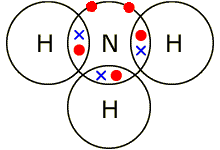2.16 recall the gases present in air and their approximate percentage by volume
Nitrogen = 78%
Oxygen = 21%
Argon = nearly 1%
Co2 (carbon dioxide) = o.o4%
The proportion of oxygen in the atmosphere can be measured through two separate experiments, one using copper and one using iron and phosphorus.
Using copper
- When heated, copper reacts with oxygen in the air to make copper (II) oxide. So this reaction uses up oxygen from the atmosphere.
- Pass a known volume of air (say 100cm^3) over hot copper in a tube using two syringes. The markers on the syringes will tell you how much oxygen has been used up.
- If you started with 100cm^3 of air, and after passing it over the hot copper you see that 20cm^3 of air has gone, then you know that that 20cm^3 would have been oxygen (oxygen is used up when copper reacts to make copper.)
- So, you could say that about one fifth of the air (20%) is oxygen.
Using Iron or Phosphorus
- Iron reacts with oxygen in the air to form rust.
- Soak some iron wool in acetic acid, which will catalyse the reaction. Push the wool into the test tube, covering the of the tube and then inverting it into a beaker of water.
- Over time, the level of water in the tube will rise. This is because the iron reacts with the oxygen in the air, making iron oxide. The water rises to fill the space that the oxygen took up.
- In order to work out the percentage of the air that is oxygen, you need to make the starting and finishing position of the water.
- Fill the tube up to each mark with water and pour the contents into a measuring cylinder to find the volume of air at the start and at the end.
- The difference between the volumes at the start and at the end will give you the percentage of the initial volume that has been used up - this should be around 21%. This tells you how much oxygen was present in the air as it is the oxygen that reacted with the rust and therefore decreased the volume.
2.18 describe the laboratory preparation of oxygen from hydrogen peroxide, using manganese (IV) oxide as a catalyst
You can make pure oxygen in the lab from hydrogen peroxide (H2O2).
Hydrogen peroxide is put in a conical flask with manganese (IV) oxide as a catalyst. The hydrogen peroxide will decompose into water and oxygen. Normally, this reaction would be slow but it can be sped up with the presence of manganese (IV) oxide, which will speed the reaction up without being used up in it. Then, you can collect the oxygen that is produced over water (using a delivery tube to bubble the gas into an upside-down measuring cylinder or gas jar filled with water,) or simple use a gas syringe to collect it.
Equation for decomposition of hydrogen peroxide into oxygen and water;
word equation: hydrogen peroxide > water + oxygen
balanced symbol equation: 2H2O2 (aq) > 2HO (l) + O2 (g)
2.19 describe the reactions of magnesium, carbon and sulfur with oxygen in air, and the acid-base character of the oxides produced
When an element is burnt in air it reacts with the oxygen to form an oxide. The oxides will either have an acidic character, or a basic character.
Magnesium
- Burns with a bright white flame in air.
- White powder is formed, this is magnesium oxide.
- Magnesium oxide is slightly alkaline when dissolved in water, so it has a basic character.
- Equation: 2Mg (s) + O2 (g) > 2MgO (s)
Bright white flame that magnesium burns with when burnt in air.
Carbon
- Will burn in air if it is very strongly heated.
- Burns with an orangey/yellow flame.
- Produces carbon dioxide gas.
- Carbon dioxide is slightly acidic when dissolved in water, it has an acidic character.
- Equation: C (s) + O2 (g) > CO2 (g)
Carbon burning in air with a yellow/orange flame.
Sulfur
- Burns in air with a pale blue flame.
- Produces sulfur dioxide.
- Sulfur dioxide is slightly acidic when dissolved in water, it has an acidic character.
- Equation: S (s) + O2 (g) > SO2 (g)
2.20 describe the laboratory preparation of carbon dioxide from calcium carbonate and dilute hydrochloric acid
- Marble chips (a metal carbonate) are placed at the bottom of a flask, and dilute hydrochloric acid is added.
- The dilute hydrochloric acid (HCI) reacts with the calcium carbonate to produce calcium chloride, water and carbon dioxide gas.
- The carbon dioxide gas is the collected in a gas syringe or using downward delivery.
- Equation: hydrochloric acid + calcium carbonate > calcium chloride + water + carbon dioxide.
2.21 describe the formation of carbon dioxide from the thermal decomposition of metal carbonates such as copper (II) carbonates.
Another way of making CO2 is by heating a metal carbonate, a process known as thermal decomposition (when a substance breaks down into simpler substances when heated.) Copper (II) carbonate is a green powder that will easily decompose upon being heated, forming carbon dioxide and copper (II) oxide. Equation for this reaction is as follows:
- CuCO3 (s) > CuO (s) + CO2 (g)

























